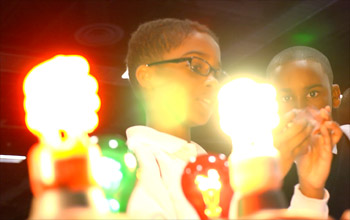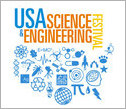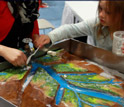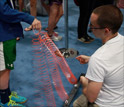Media Advisory 16-004
NSF hosts 26 hands-on exhibits at largest U.S. science and engineering festival
From robots to spiders and gravitational waves to brain scans, visitors can experience full scope of NSF-supported research
April 13, 2016
This material is available primarily for archival purposes. Telephone numbers or other contact information may be out of date; please see current contact information at media contacts.
Augmented reality sandboxes, mammoth robotic sculptures, the science of guitars, and actor Wil Wheaton's crowning of winners from the National Science Foundation (NSF) competition, Generation Nano: Small Science, Superheroes, are just a few NSF activities that visitors can experience at the fourth USA Science & Engineering Festival in Washington, D.C., April 15-17, the nation's largest science and engineering festival.
The free event aims to inspire next-generation inventors and innovators through more than 3,000 hands-on exhibits, experiments and live performances by science celebrities, inventors and subject-matter experts. The festival is expected to draw more than 350,000 attendees.
In NSF's section, science and engineering researchers and educators will present projects that reflect NSF-supported diverse explorations, providing a glimpse into knowledge, innovation and educational resources that result from investment in fundamental research.
Adults and children alike will enjoy opportunities to experience science and engineering up close and hands-on.
|
What: |
USA Science and Engineering Festival |
|
When: |
Sneak peek, Friday, April 15, 9 a.m. to 3 p.m. |
|
Where: |
Booth 423, Hall A |
|
Why: |
To engage with fascinating, interactive (often NSF-funded) exhibits and shows (detailed below) |
To learn more, visit USA Science & Engineering Festival website and check out this video.
To speak with exhibitors about their work, journalists should contact NSF's Bobbie Mixon to help arrange onsite interviews: bmixon@nsf.gov, (703) 292-8070.
During Sneak Peek Friday and throughout weekend festivities, @NSF will tweet stories and pictures in real time of children and adults interacting and learning. For additional up-to-the-minute information, follow NSF's official event hashtag #NSFSuperScience.
Summaries of exhibits and live events spotlighting NSF-funded projects:
Exhibits
Shaping Our World (University of California, Davis)
Combining 3-D and augmented reality technology with a traditional sandbox, the "Shaping Our World" Augmented Reality Sandbox offers a powerful open-source tool which taps into users' sense of curiosity and exploration to help educators, students, scientists and policymakers alike visualize and better understand geoscience principles and environmental processes.
Brain in Action (Pennsylvania State University)
Your brain is smarter than the smartest computer! Learn how your brain works by watching live recordings of the brain in action. You can also train your brain by doing fun, mind-boggling language and thinking games.
Jamming-Based Soft Robotics (University of Chicago)
NSF-funded Materials Research Science and Engineering Centers drive innovation where basic research creates opportunities for new industrial applications. Learn how fundamental science concepts led to development of a soft robotic gripper.
Touch Feedback for Virtual Reality (Tactical Haptics)
Tactical Haptics is revolutionizing human-machine interfaces through a new type of touch feedback that is more realistic than industry-standard vibration feedback. Attendees will get a chance to experience next-generation touch feedback before it is commercially available.
Dinosaurs and the Deep Seafloor (NSF: OCE Marine Geology and geophysics)
The exhibit demonstrates how sediment cores obtained from the deep seafloor can be used to study past events. Students will observe and use critical thinking skills to explain patterns they see in sediment cores and obtain a better understanding of how marine geology helps to understand extreme events such as the extinction of dinosaurs.
Eight-Legged Encounters (University of Nebraska-Lincoln)
Eight-legged Encounters blends art and science to inspire scientific discovery and increase public understanding of the diversity and evolution of spiders and their relatives. Games, trading cards, stamps, and opportunities for up close encounters with live animals will blow your mind!
Earth Changes from Sand to Sky (University of Alaska Fairbanks)
See the landscape change -- under your hands and from the air. Augmented reality tools and mini-copters show how we are all agents of change in our environments.
Forecasting Fun (University of Washington)
Can you conquer chaos? Give it a try by experimenting with our compound pendulum and learn why meteorologists have a hard time forecasting weather.
Generation Nano (NSF and the National Nanotechnology Initiative)
Come meet our Generation Nano Competition finalists and learn about their nanotechnology-enabled superheroes.
Going Green! MSOSW (University of North Texas)
The exhibit will highlight scenarios for conserving energy and reducing global production of greenhouse gases. Stand-by power consumption, also known as "vampire power," is a rapidly growing area of global concern due to increasing electrical devices with "instant on" features in our modern world.
Gravitational Waves: New View on the Universe (LIGO Scientific Collaboration and University of Glasgow, UK)
Discover the amazing story of the Laser Interferometer Gravitational-Wave Observatory (LIGO) and learn how it detected ripples in spacetime from colliding black holes 1.3 billion light years away -- opening a whole new window on the universe.
STEM Guitar Project (Sinclair Community College)
The STEM Guitar Project helps faculty increase students' interest and engagement of STEM principles by teaching how an electric guitar is designed and built. Faculty from middle school through university level are using these tools in 36 states in the US and in Canada. Last year, over 1,300 students and faculty constructed an instrument through this project.
Little Shop of Physics (Colorado State University)
Check out the Little Shop of Physics' 50+ hands-on experiment stations. You can explore concepts ranging motion to magnetism, guided by our tie-dye-clad staff.
Muscles in Action (University of Delaware)
The Monitor Your Movement exhibit engages participants in an interactive biofeedback experience. With a simple flex of their muscles, participants can see the electrical output generated by their movement on-screen.
Next Generation Network Literacy (U.S. Military Academy at West Point)
We live in a highly connected world that allows instantaneous communication, rapid transport of people and goods, and sometimes the spread of disease. This exhibit teaches network literacy, basic knowledge about how networks can be used as a tool for discovery and decision-making, and informs the public about both benefits and pitfalls of living in a networked world.
Painting With Polarized Light (National Optical Astronomy Observatory)
Polarized light is all around us and used in everything from sunglasses to LCD televisions to 3D movies. Learn about polarized light's curious properties and try your hand at creating art out of cellophane tape as you paint with polarized light!
Pandas and You (Michigan State University)
Two decades of studying pandas in a remote corner of China have provided lessons in sustainability that have resonated across the globe. The work is synthesized in the book, "Pandas and People Coupling Human and Natural Systems for Sustainability." It turns out we've learned a lot from pandas.
The Science Behind Pixar (Museum of Science, Boston)
Learn about the science, math and creativity behind Pixar Animation Studio's technical pipeline at three exhibits from the Science Behind Pixar exhibition. Use a touch-screen to build a set for the movie "Brave," hear a Pixar scientist talk about the mathematics of set design, and procedurally generate a set with blocks and dice.
SeeMore: Kinetic Computer Sculpture (Virginia Tech)
Ever wonder what happens "in the cloud" when you conduct a Google search or send a tweet? Come meet SeeMore, the 10-foot tall, 1-ton, collaborative brainchild of a computer scientist and an artist that visually demonstrates parallel computational thinking through motion.
Design Squad Global (WGBH Educational Foundation )
Get hands-on with Design Squad Global! Try out Seismic Shake-Up: Build a structure and find out whether it will survive an earthquake by testing it out on a shake table. Or experience Pop Fly: Build a catapult that will launch a ping pong ball into a target.
Science Behind the Shield (University of California, Riverside)
This exhibit will feature the story behind the creation of Captain America's iconic star-spangled shield and help you understand the mechanical behavior of ultra-high strength lightweight metallic materials. The display will feature a replica shield, images from comic panels illustrating the story of the creation of the shield, and demonstrations showing amazing possibilities for advance metallic materials for future defense, transportation and healthcare applications.
Turtle Ants and their Gut Symbionts (George Washington University)
How do beneficial bacteria allow for evolution of remarkable animal features? Increasingly, we learn how "good bacteria" are the secret to all kinds of animals' survival. The turtle ants, one of nature's great tropical success stories, are showing us how their incredible body armor is dependent on raw materials provided by beneficial bacteria in their guts.
The Think Tank (University of Chicago)
The Think Tank is a mobile neuroscience lab and education station designed to accelerate diverse participation in STEM. The project aims to empower a new generation of STEM leaders through hands-on science education and community engagement.
Thinking and Tinkering (Rensselaer Polytechnic Institute)
Imagine you can experience the amazing lives of engineers and scientists as they help solve key problems of modern life by adding low cost, easy-to-use tools to your laptop. With these tools, a student can investigate how a smart system can sense our environment, make a decision on how to improve it and actuate a device that enhances our lives' quality.
WaterSim: Water Simulation Model (Arizona State University)
WaterSim is a tool that estimates water supply and demand for the Phoenix Metropolitan Area. Users can explore how various scenarios of regional growth, drought, climate change impacts and water management policies influence water sustainability.
Live Events
Saturday, April 16, 2-2:50 p.m. (Career Pavilion)
Meet the Scientist/Engineer
NSF has been supporting super science and engineering for over 65 years. NSF plays a vital role in driving the U.S economy, enhancing our nation's security and sustaining the U.S. position as a global leader. Come talk to NSF scientists and engineers who enable the advancement of discovery, innovation and education beyond the frontiers of current knowledge, and empower future generations in science and engineering.
Sunday, April 17, 10:30-10:50 a.m.
Generation Nano Competition Award Ceremony (Main Stage)
Come meet Generation Nano Competition finalists in person at NSF's exhibit area, April 16-17. American actor Wil Wheaton will announce winners, where you could win a poster signed by the iconic comic creator, Stan Lee. These high school competitors created original superheroes whose "powers" are driven by nanotechnology.
-NSF-
-
The 4th USA Science & Engineering Festival will be the largest science festival in the nation.
Credit and Larger Version -
View Video
Festival exhibitors show how models can help harness energy and restore free-flowing rivers.
Credit and Larger Version -
View Video
Festival exhibitors show kids just how hard it is to be a spider due to their poor vision.
Credit and Larger Version
Media Contacts
Bobbie Mixon, NSF, (703) 292-8070, email: bmixon@nsf.gov
Related Websites
USA Science & Engineering Festival: http://www.usasciencefestival.org/
The U.S. National Science Foundation propels the nation forward by advancing fundamental research in all fields of science and engineering. NSF supports research and people by providing facilities, instruments and funding to support their ingenuity and sustain the U.S. as a global leader in research and innovation. With a fiscal year 2023 budget of $9.5 billion, NSF funds reach all 50 states through grants to nearly 2,000 colleges, universities and institutions. Each year, NSF receives more than 40,000 competitive proposals and makes about 11,000 new awards. Those awards include support for cooperative research with industry, Arctic and Antarctic research and operations, and U.S. participation in international scientific efforts.
Connect with us online
NSF website: nsf.gov
NSF News: nsf.gov/news
For News Media: nsf.gov/news/newsroom
Statistics: nsf.gov/statistics/
Awards database: nsf.gov/awardsearch/
Follow us on social
Twitter: twitter.com/NSF
Facebook: facebook.com/US.NSF
Instagram: instagram.com/nsfgov






